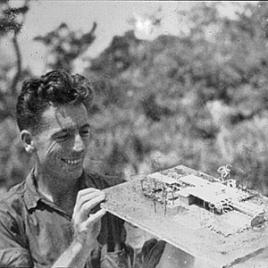On East Ridgewood Avenue, near RHS, people walking to school may pass a large structure, mingled with several large trees and made of natural materials. It looks like nothing else in suburban Ridgewood, boasting no clear front entrance, roof, or lawn, but is one of its most well-known buildings.
“This site is canonical,” says Kevin Hoffmann, Assistant Director and current inhabitant of the James Rose Center, based at the James Rose House. “It’s the most significant residence of landscape architecture I know of.” Landscape architecture is defined as “the design of outdoor areas, landmarks, and structures that achieve environmental, social-behavioral, or aesthetic outcomes.” But James Rose was not concerned with definitions and expectations.
James C. Rose, born in 1913, moved to New York City from rural Pennsylvania after the death of his father when he was five, with his mother and older sister. He never graduated from high school, due to his refusal to take music and mechanical drafting classes, but was able to enroll in Cornell University architecture classes, and transferred to Harvard University a few years later. He did not receive a diploma there, as he was expelled for refusing to submit works in the French Beaux-Arts style, a classical style from the early 1800s that can be seen in such buildings as New York City’s Grand Central Terminal and Metropolitan Museum of Art. Rose was intent on developing a less scripted, more progressive style.

Rose served in Okinawa, Japan during World War II, after which he briefly worked with Frank Lloyd Wright colleague Antonin Raymond, and he returned to New York City to start a large practice with both domestic and international clients. But Rose rejected his involvement in large corporate projects and moved to New Jersey, where he began to work on mostly residential commissions. He built his Ridgewood home in 1953, and continued to work on it for almost four decades until his death in 1991 as a result of cancer. During that time, he made visits to Japan, including visits on invite from the Japanese government for the first annual World Design Conference. He drew major inspiration from, ironically, the traditional aspects of Japanese design and spirituality, both in his architecture, gardening, and personal life. But Hoffmann says nothing offended Rose more than asking him if he liked Japanese gardens. He says Rose would agree that a categorization “inherently misses” aspects of his architecture, and “deprives of the opportunity to assess.”
The James Rose Center came to be a result of a sort of rediscovery of James Rose by Dean Cardasis, a practicing landscape architect, Professor Emeritus of Landscape Architecture at Rutgers University, and Director of the Center. The James Rose House vanished from public view and was found in Ridgewood by Cardasis. They worked on the Ridgewood home together, during which Rose published several books about his theory and his thoughts on popular American architecture after World War II. The James Rose Center was established by Rose, Cardasis, and some of Rose’s close friends just before Rose’s death in order to preserve the center—it was threatened with complete destruction as result of fire and water damage in the 1980s—and to preserve Rose’s spirit of design.

Currently, the James Rose House is still in a state of change: it is renovating. Rose wrote of it once as something that would “never be ‘finished’… such as we find commonly in nature.” In November 2016, a large willow on the House’s grounds fell on the Zendo, a meditation space on the roof that Hoffmann describes as the House’s “spiritual center”, destroying it. “How do you renovate what is meant to change?” asks Hoffmann. “Rose wouldn’t have asked ‘What would Rose do.’” The center is currently collaborating with the Bergen County Historic Preservation Grant Program in a legal state of “rehabilitation,” which allows for repairs or alterations to a historic structure while still conveying its cultural, historical, or architectural values. It is more of an open-ended means of repair.
The James Rose Center currently holds tours from 10 AM to 4 PM Tuesdays through Sundays, and a biography of Rose by Dean Cardasis was published last year.
Daniel Greenman
staff writer
Graphics: The Cultural Landscape Foundation
